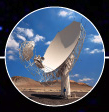The NenuFAR project
1 : Laboratoire de Physique et Chimie de l'Environnement et de l'Espace
(LPC2E)
-
Site web
CNRS : UMR7328, Université d'Orléans, Observatoire de Paris
3A, Avenue de la Recherche Scientifique 45071 Orléans cedex 2 -
France
2 : Unité Scientifique de la Station de Nançay
(USN)
-
Site web
CNRS : USR704, Observatoire de Paris, Université d'Orléans
18330 NANCAY -
France
3 : Laboratoire d'études spatiales et d'instrumentation en astrophysique
(LESIA)
-
Site web
Université Pierre et Marie Curie [UPMC] - Paris VI, Observatoire de Paris, INSU, CNRS : UMR8109, Université Paris VII - Paris Diderot, Université Pierre et Marie Curie (UPMC) - Paris VI
5, place Jules Janssen 92190 MEUDON -
France
4 : Astrophysique Interactions Multi-échelles
(AIM)
-
Site web
CEA, Université Paris VII - Paris Diderot, INSU, CNRS : UMR7158
Service d'astrophysique Orme des Merisiers F-91191 GIF SUR YVETTE CEDEX -
France
I will present NenuFAR (New Extension in Nançay upgrading LOFAR), launched as an extension to FR606, the french LOFAR station. Following a definition and prototyping study under a previous ANR contract, it will consist in a set of 15 (phase 1) to 96 (full project) mini-arrays (MA) of 19 antennae each. The MAs will be analog-phased, and optimized for the full 15-80 MHz band.
With the addition of a dedicated receiver, NenuFAR will be both and simultaneously
- an addition to LOFAR, the europe-wide Low-Frequency Array, of which it will significantly increase the capabilities as an alternative to the LBA of FR606;;
- and a stand-alone instrument, available for an original and autnonomous scientific program.

 PDF version
PDF version
